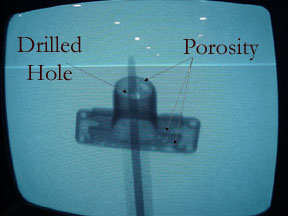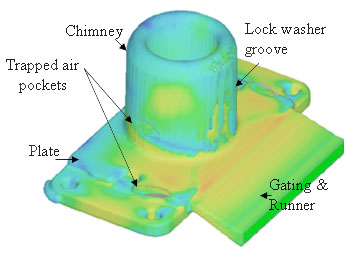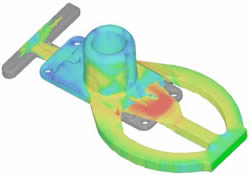
Improving High Pressure Die Casting Designs
The content for this article was contributed by Mark Littler of Littler Diecast Corporation.
Littler Diecast Corporation, a producer of high pressure die castings, was recently able to redesign and die cast an electrical switch frame for an aerospace application. Formerly produced by a different manufacturer, there were defect problems in a high number of the castings and a new design was needed to achieve a lower scrap rate. Littler Diecast was able to demonstrate that they could pinpoint the defects through simulation without previous knowledge of the problems. This impressed the client enough to land them the job.
Identifying the Problem
The switch is cast from A380 aluminum and is approximately 1 ¼” x 1” x 1/2” in size. Littler Diecast found that porosity problems were plaguing the part in two locations: the plate and the chimney. This was confirmed by the customer. Holes were forming in each of the locations because of the way the part filled. The flow would enter through a single gate as shown in Figure 1, jet to the far side of the plate and then backfill, trapping air pockets that do not always close due to early solidification. The same problem was found in the chimney: fluid would jet to its furthest extent and then backfill, creating trapped air that could not vent through the parting line.
The Original Part Design
There were other problems with the original design of the part. There was a lot of die erosion around the slot for the lock washer and the sealing surfaces on the bottom of the plate. The overflows located at the corners of the part were not large enough to allow defects to flow out.
Using FLOW-3D, Littler Diecast was able to analyze the flow behavior and visually determine what was occurring. With such a small part, early solidification is a problem due to the rapid cooling in thin sections. If flow jets across the part and back, the fluid has more time to cool and create entrapped air. It is best to have the hottest liquid coming in last. With this in mind, Littler Diecast was able to test a number of ideas and achieved a design that minimized the potential for problems and maximized the process window.
The Final Part Design
After three major design changes, the part quality was vastly improved. First, the gating and runner was redesigned so the fluid entered through three gates in an entirely new direction. This, combined with the second design change of creating a larger overflow, meant that there was much less back flow in the plate allowing the hottest fluid to enter last. Third, the approach angle and locations of the gates were altered, which helped to prevent backflow in the chimney.
This new design also reduced the potential for die erosion in the new tool. Instead, fluid would jet onto a core pin used for the center hole in the chimney. The core pin is easily replaced, a much faster and less expensive repair than repairing the die steel. All of these design changes took place before any new die steel was cut eliminating the costly process of engineering changes if problems are discovered after the tooling has already been produced.
Physical Verification
After the trial run of the production tool, Littler Diecast was able to verify the design changes through short shots, x-rays and destructive tests. The short shots showed a balanced runner, and there was no porosity visible in the x-rays. Break testing showed a consistent crystalline grain structure with no voids, demonstrating that the failure was due to the strength of the material and not a casting defect.
Learn more about the versatility and power of modeling metal casting processes with FLOW-3D CAST.




